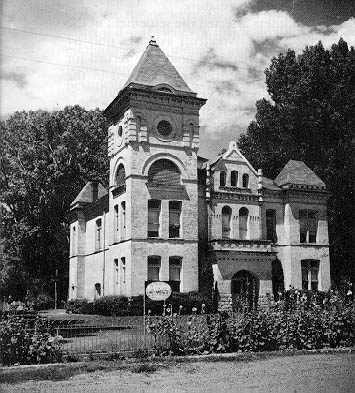Piute County Area: 754
763 Ssquare miles - .92 percent of state - 25th County in size.
Population (1999 est.):
1,535;
County seat:
Junction;
Origin of County Name:
was evolved from the Paiute (Pah Ute) Indians;
Principal Cities/Towns:
Circleville (492), Marysvale (418), Junction (149), Kingston (158), Balance of Piute County estimated population (267); (population estimates source: US Census Bureau)
Economy:
Tourism, agriculture (primarily beef and dairy cattle), education, trucking;
Points of Interest:
Piute ATV Trail, Bullion Miners Park, Big Rock Candy Mountain, Historic Piute County Court House, Tushar Mountains, Otter Creek and Piute reservoirs, Piute County Courthouse, Parker ranch/Butch Cassidy home. Piute County was split off from Beaver County in 1865. Its western boundary approximates the crest of the Tushar Mountains with the highest peaks in the High Plateaus section of the Colorado Plateau. Most of the population is concentrated in the Sevier River Valley. Grass Valley (Otter Creek) lies between the Sevier Plateau in the center of the county and the Parker Range on the eastern border. Evidence of prehistoric inhabitants has been found in the caves of Kingston Canyon (now an attractive local recreation area). The county has been occupied by both the Fremont and the later Paiute Indians who were mainly gatherers and hunters of food and who produced beautiful baskets for many uses and rabbit-skin clothing for winter protection. Circleville and Junction were settled in 1864 by a group of Mormon pioneers from Ephraim. The Sevier Valley provided good grazing, and livestock remains important to the economy. Wild hay, alfalfa, grain, and pastures provide feed for the limited beef and dairy production. Earth-covered potato cellars remain as evidence of a successful crop in an earlier era. Piute County Courthouse, Junction, built in the early 20th century, is listed in the National Register of Historic Places. 
Kimberly, 1917, was one of several mining boom towns in Piute that brought economic prosperity to the county in the late 19th century. The Piute School District employs 50 residents. Less obvious contributors to the local economy are a small group of retirees in the larger towns. As in most of Utah's rural counties, "home" has a strong pull on the natives while economic forces tend to push recent high school graduates toward the opportunities of urban areas. Piute residents depend on nearby Richfield north on Highway 89 for major services. Earth's riches once played a dominant role in the economy. A gold and silver boom in the Tushars spawned such towns as Bullion, Kimberly, and Marysvale. The Ohio Mining District was organized in 1868, and by 1872 Bullion Canyon boasted 50 buildings and hundreds of eager miners. Kimberly, in the Gold Mountain District, developed around the rich Annie Laurie claim, located in 1891. The completion of a Denver and Rio Grande Railroad branch line to Marysvale in 1900 linked Piute's mines and farms to the marketplace. Later, lead, zinc, alunite, and uranium were significant products. Piute's huge reserves of high-grade alunite ores were especially important during World Wars I and II. Cyclical mining, now in a bust mode, could boom again. Recreational activities also create some job opportunities. Piute and Otter Creek reservoirs provide good boating, water skiing, and fishing. The Parker ranch just south of Circleville has become a tourist attraction because of its association with outlaw Butch Cassidy. |